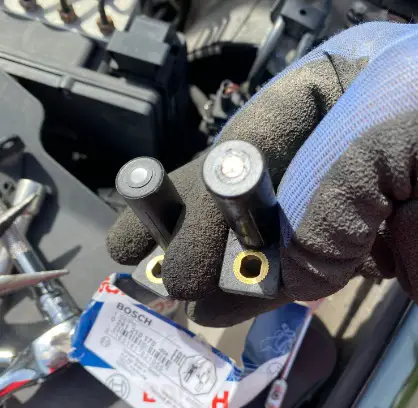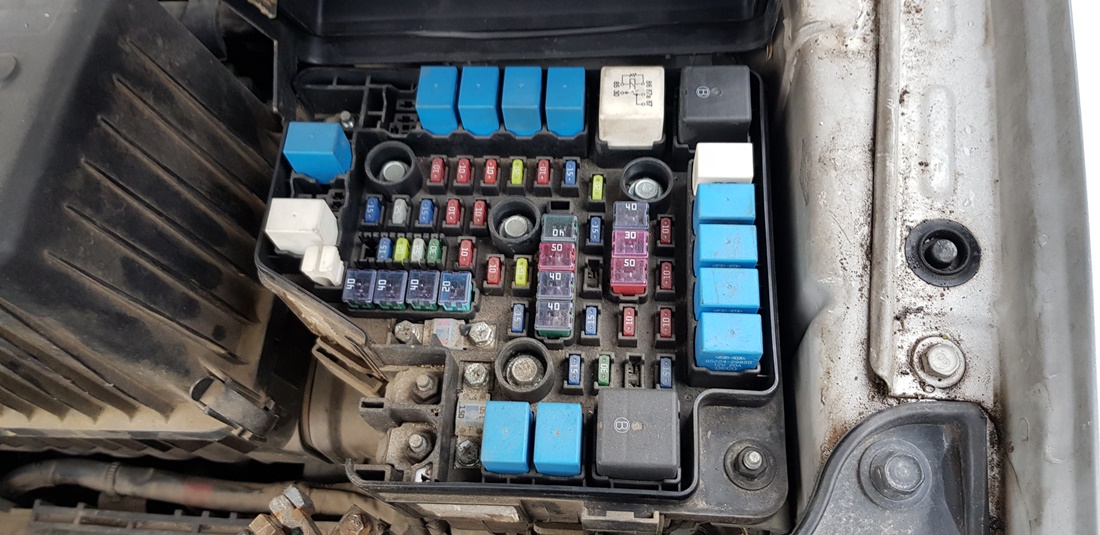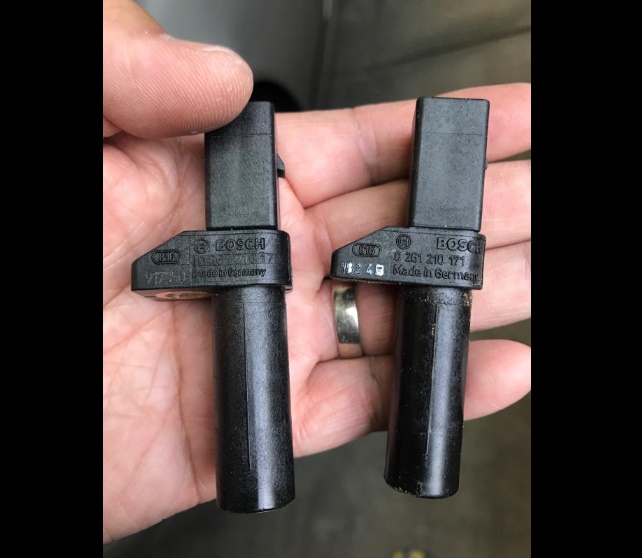At least once in a while, the check engine light turns on. This could be due to some technical failure.
But, what happens if you had your light ON for some time and then it turns off? Can it do that?
- What Does The Check Engine Light Means?
- Can Check Engine Light Turn Itself Off?
- Why Does The Check Engine Light Turn Itself Off?
- Is It Safe To Drive With Check Engine Light On?
- Check Engine Light Went Off After a Day
- Why The Mechanic Isn’t Able To See The Issue
- Can I Diagnose The Check Engine Problem Myself?
- In Conclusion
Key Takeaway
- The check engine light, also known as the malfunction indicator lamp, signifies that there’s an issue with your vehicle, which can range from minor problems like a loose gas cap to major issues such as a failing catalytic converter or engine failure.
- The check engine light can turn itself off if the condition that caused it to come on is no longer present; however, this doesn’t necessarily mean the problem has been fully resolved.
- While it is generally safe to drive with the check engine light on for a short distance (50 to 100 miles) if the car seems to be running okay and the light isn’t flashing, it’s recommended to have your vehicle inspected as soon as possible to prevent potential serious damage.
What Does The Check Engine Light Means?
The check engine light is a part of your vehicle’s onboard diagnostic system. When it illuminates, it signals that the system has detected a problem that could impact the vehicle’s performance or emissions.
The issues can range from simple to complex. For instance, it could come on if your gas cap is loose, cracked, or not properly sealed.
This is a minor issue, but it can cause fuel to evaporate, leading to decreased fuel efficiency and increased emissions.
On the more serious end, the check engine light could signal problems with your engine’s performance, such as a malfunctioning oxygen sensor or catalytic converter, or issues with the ignition system like a misfiring spark plug.
These problems could lead to decreased performance, lower fuel economy, and increased emissions.
Can Check Engine Light Turn Itself Off?

Yes, the check engine light on your vehicle can turn itself off and typically occurs when the issue that caused it to turn on in the first place has been resolved.
When some car system fails to pass a test the check engine light turns On. It takes 2 failures for the light to turn on. After your car has failed to pass those 3 tests, it takes 40 passes in order for the light to turn itself off.”
If the problem is intermittent or if the condition that triggered the light improves, the light may turn off by itself. For instance, if your gas cap was loose (a common cause for the light to come on) and you tighten it, the light should go off after a few driving cycles.
However, even if the light turns off, the trouble code will likely remain in the system’s memory until it’s manually erased with a scan tool. It’s also worth noting that while the light might turn off, the issue may not be entirely resolved and could reoccur.
Why Is My “Check Engine” Light On?
Why Does The Check Engine Light Turn Itself Off?

So, let’s say that your check engine light is on and you take your car to the mechanic. The mechanic takes your car out for a ride and comes back with the check engine light turned off. Why does that happen?
Well, at some point that car has passed the test three times. It takes three times of passing these tests, whatever tests had failed, will turn the light off.
At this point, you might feel that maybe you don’t actually have an engine problem, but it’s best if you let the mechanic run some diagnostics. Even with the light turned off, the technicians can see which test has failed and why the check engine light was turned on in the first place.
Is It Safe To Drive With Check Engine Light On?
If nothing seems to be wrong with the engine, transmission, or the way the car is driving it means that a non-evasive sensor has failed or a simple mechanical failure is present such as a vacuum leak has occurred, you can then continue driving without additional damage to any components.
This is because the computer is equipped with predetermined values for each sensor which enables the engine to keep running without issue. This computer mode is called ‘limp mode’. This gives you time to get the car to the repair garage or to read the codes yourself and perform repairs to help save you money.
Check Engine Light Went Off After a Day
If your check engine light went off after a day, it might indicate that the problem which triggered the light was temporary or intermittent.
The check engine light is part of your vehicle’s onboard diagnostic system, which continuously monitors various aspects of your vehicle’s performance.
When it detects an issue, it triggers the check engine light and stores a corresponding trouble code.
For example, if your gas cap was loose and you tightened it, or if there was a temporary issue with your fuel quality, the light could turn off after a few driving cycles once the condition has resolved.
However, just because the light has turned off doesn’t necessarily mean that the issue is completely fixed.
The trouble code that triggered the light will usually remain stored in the system until it’s manually cleared. This could be helpful for a mechanic in diagnosing any recurring issues says VaTire.
Why The Mechanic Isn’t Able To See The Issue
Sometimes the mechanics are not able to tell you what your issue is. What Audi and Volkswagen do, after 40 passes of the same test, both the light is off and the error code is gone. After your car performs 40 tests and they all pass, the mechanic could run diagnostics but he won’t be able to see any errors.
Can I Diagnose The Check Engine Problem Myself?
Yes, you can do that. But, in order to do that, you will need an OBD scanner. You will have to connect this scanner to the car’s main computer which is pretty easy. This type of scanner is connected to your mobile phone and you will receive the error codes on your mobile phone.

Here are some of the most common error codes that you will get:
- Oxygen Sensor Code: P0171-P0175. This error code appears when you have a faulty oxygen sensor. This sensor monitors the amount of oxygen in the exhaust and gives this information back to your engine computer so it knows how to adjust the fuel mixture.
- Engine Misfire Code: P0300-P0305. This is a very common issue as well. This happens when one or more cylinders are not functioning properly. The mechanics work on these issues on a daily basis. The OBD Scanner is able to diagnose this issue without a problem.
- Evaporative System Code: P0411, P0440, P0442, P0446, P0455. The EVAP has a mission to contain and remove vapors that are created when fuel is burned. Even a loose gas gap that allows the vapors to escape from the fuel tank can trigger this failure code.
- Exhaust Gas Recirculation Code: P0401. The EGR controls the emission of smog from the engine. This could be if you don’t change your engine oil on time or you drive your car on short trips without warming it up which will cause carbon buildup.
- Catalytic Converter Code: P0420, P0430. This device converts toxic gases into less toxic pollutants. This is a very important part of the vehicle, but will eventually become worn out and will have to be changed.
FAQs
Q: What should I do if the Check Engine Light turns off?
A: If the Check Engine Light turns off on its own, it is still a good idea to have your vehicle checked by a professional. Even though the light may have turned off, it does not guarantee that the underlying issue has been resolved. A mechanic can perform a diagnostic scan to check for any stored trouble codes and ensure that your vehicle is in good operating condition.
Q: Can a loose gas cap cause the Check Engine Light to turn off?
A: Yes, a loose or improperly sealed gas cap is one of the most common reasons for the Check Engine Light to come on. If the gas cap is not tightened properly, it can cause an evaporation system leak, triggering the light. However, once the gas cap is tightened or replaced correctly, the system may detect that the issue has been resolved and turn off the Check Engine Light.
Q: How long does it take for the Check Engine Light to turn off after the issue is fixed?
A: After fixing the underlying issue that caused the Check Engine Light to come on, it can take a few driving cycles for the system to recognize that the problem has been resolved and turn off the light. This typically involves driving the vehicle for about 50 to 100 miles under varying conditions. However, the exact duration may vary depending on the make and model of your vehicle.
Q: Can a dead battery cause the Check Engine Light to turn off?
A: No, a dead battery itself does not directly cause the Check Engine Light to come on or turn off. However, if the battery becomes completely discharged, it may cause temporary electrical malfunctions in the vehicle’s systems, including the engine management system. This can result in the Check Engine Light turning on or off. It is advisable to address the battery issue and have the vehicle inspected by a professional.
Q: Can a faulty oxygen sensor cause the Check Engine Light to turn off?
A: No, a faulty oxygen sensor is more likely to cause the Check Engine Light to come on rather than turn off. The oxygen sensor plays a crucial role in monitoring the oxygen levels in the exhaust system. If it detects an issue or malfunction, it will trigger the Check Engine Light. A faulty oxygen sensor should be diagnosed and replaced to resolve the issue and turn off the light.
Q: Can a bad spark plug cause the Check Engine Light to turn off?
A: No, a bad spark plug is unlikely to cause the Check Engine Light to turn off. In fact, a bad spark plug can lead to engine misfires and other performance issues, which may trigger the Check Engine Light to come on or stay illuminated. If you suspect a problem with your spark plugs, it is best to have them inspected and replaced if necessary.
Q: Can extreme cold weather cause the Check Engine Light to turn off?
A: Extreme cold weather itself does not directly affect the Check Engine Light. However, it can indirectly contribute to certain conditions that may trigger the light. For example, extremely cold temperatures can affect the performance of the vehicle’s sensors, fuel lines, and other components, potentially leading to issues that trigger the Check Engine Light. If the light turns on during cold weather, it is important to have your vehicle checked to identify any underlying issues.
Q: Can a transmission problem cause the Check Engine Light to turn off?
A: Yes, a transmission problem can cause the Check Engine Light to come on, but it is less likely to cause the light to turn off on its own. Transmission issues can have a significant impact on the vehicle’s performance and can result in the light remaining illuminated until the problem is resolved. If you suspect a transmission problem, it is best to have a professional diagnose and repair the issue.
Q: Can a loose or damaged fuel cap cause the Check Engine Light to turn off?
A: No, a loose or damaged fuel cap is more likely to cause the Check Engine Light to come on rather than turn off. A loose or damaged fuel cap can lead to fuel vapor leaks, triggering the Check Engine Light. If the issue is not resolved, the light will remain illuminated. It is important to ensure that your fuel cap is properly tightened or replaced if necessary.
Q: Can bad fuel quality cause the Check Engine Light to turn off?
A: Bad fuel quality is unlikely to cause the Check Engine Light to turn off. However, contaminated or poor-quality fuel can lead to performance issues and potentially trigger the Check Engine Light to come on. If you suspect bad fuel quality, it is recommended to have your fuel system inspected and consider using a fuel additive to clean the system and optimize performance.
In Conclusion
In conclusion, yes, the check engine light can turn itself off if the condition that triggered it improves or is resolved.
However, this doesn’t necessarily mean that the problem has completely disappeared.
The corresponding trouble code usually remains stored in the vehicle’s computer system until it’s manually cleared.
Therefore, even if the light turns off, it’s still advisable to have your vehicle inspected by a professional to ensure there aren’t any lingering issues.
Regular vehicle maintenance and prompt attention to the check engine light can help prevent minor issues from escalating into major, more costly repairs.




